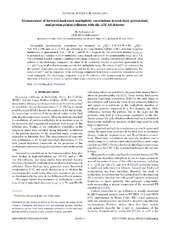Measurement of forward-backward multiplicity correlations in lead-lead, proton-lead, and proton-proton collisions with the ATLAS detector
Aaboud, Morad; Aad, Georges; Abbott, Brad; Abdallah, Jalal; Abdinov, Ovsat Bahram oglu; Abeloos, Baptiste; Aben, Rosemarie; AbouZeid, Hass; Abraham, Nadine L.; Abramowicz, Halina; Buanes, Trygve; Dale, Ørjan; Eigen, Gerald; Kastanas, Alex; Liebig, Wolfgang; Lipniacka, Anna; Martin dit Latour, Bertrand; Mæland, Steffen; Smestad, Lillian; Stugu, Bjarne; Yang, Zongchang; Zalieckas, Justas; Bugge, Magnar Kopangen; Cameron, David Gordon; Catmore, James Richard; Feigl, Simon; Franconi, Laura; Garonne, Vincent; Gjelsten, Børge Kile; Gramstad, Eirik; Morisbak, Vanja; Nilsen, Jon Kerr; Ould-Saada, Farid; Pajchel, Katarina; Pedersen, Maiken; Raddum, Silje Hattrem; Read, Alexander Lincoln; Røhne, Ole Myren; Sandaker, Heidi; Serfon, Cédric; Stapnes, Steinar; Strandlie, Are; Abreu, Henso; Abreu, Rômulo F.; Abulaiti, Yiming; Acharya, Bobby S.; Adamczyk, Leszek; Adams, David; Adelman, Jareed; Adomeit, Stefanie; Adye, Tim; Affolder, Anthony Allen; ATLAS, Collaboration
Peer reviewed, Journal article
Published version

Åpne
Permanent lenke
https://hdl.handle.net/1956/18310Utgivelsesdato
2017-06Metadata
Vis full innførselSamlinger
Originalversjon
https://doi.org/10.1103/physrevc.95.064914Sammendrag
Two-particle pseudorapidity correlations are measured in \(\sqrt{s_{\rm{NN}}}\) = 2.76 TeV Pb+Pb, \(\sqrt{s_{\rm{NN}}}\) = 5.02 TeV \(p\)+Pb, and \(\sqrt{s}\) = 13 TeV \(pp\) collisions at the LHC, with total integrated luminosities of approximately 7 \(\mu\mathrm{b}^{-1}\), 28 \(\mathrm{nb}^{-1}\), and 65 \(\mathrm{nb}^{-1}\), respectively. The correlation function \(C_{\rm N}(\eta_1,\eta_2)\) is measured as a function of event multiplicity using charged particles in the pseudorapidity range \(|\eta|<2.4\), The correlation function contains a significant short-range component, which is estimated and subtracted. After removal of the short-range component, the shape of the correlation function is described approximately by \(1+\langle{a_1^2}\rangle \eta_1\eta_2\) in all collision systems over the full multiplicity range. The values of \(\sqrt{\langle{a_1^2}\rangle}\) are consistent between the opposite-charge pairs and same-charge pairs, and for the three collision systems at similar multiplicity. The values of \(\sqrt{\langle{a_1^2}\rangle}\) and the magnitude of the short-range component both follow a power-law dependence on the event multiplicity. The \(\eta\) distribution of the short-range component, after symmetrizing the proton and lead directions in \(p\)+Pb collisions, is found to be smaller than that in \(pp\) collisions with comparable multiplicity.
